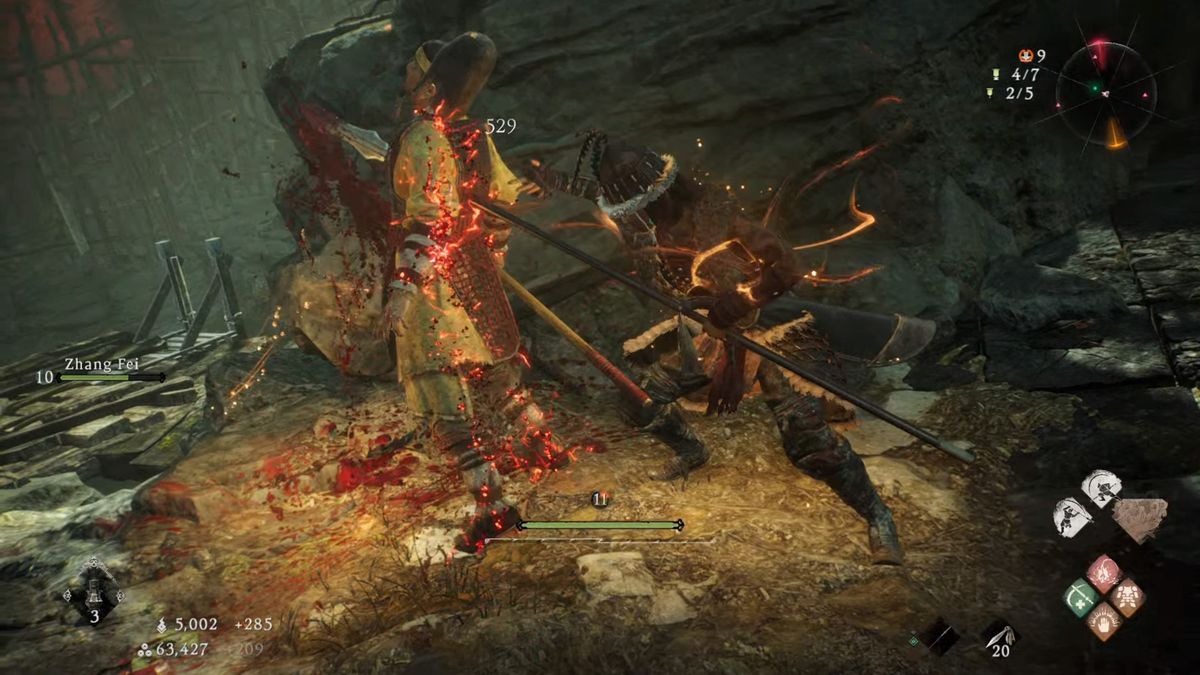12DOVE Verdict
Wo Long sees Team Ninja build on the core quality of the Nioh games. Its new systems, from the spirit gauge to morale levels within each stage feel well-considered and tightly honed to encourage exploration and bold, expressive fighting styles. Some old habits die hard, especially the tiresome loot gathering, but the game's core combat and traversal options always shine through.
Pros
- +
Supreme parrying-based combat
- +
Formidable enemies and bosses
- +
Strong level design that demands exploration
Cons
- -
The loot system is a bore
- -
Not much motivation from the story
Why you can trust 12DOVE
The first time one of Wo Long: Fallen Dynasty's tiger demons lunges towards you in a blur of flesh-shredding claws, you'd be forgiven for freezing in your tracks. Rest assured though that you can stand firm against such a blitz and emerge the victor. Soon, you'll face the same beast and deflect each one of its swipes, even its combo-ending belly flop – like it's doing an impression of a tiger skin rug – then skewer its evil heart. Now you're glowing with pride. Such is the way of the warrior in Team Ninja's latest all-action RPG.
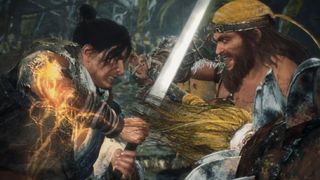
Release date: March 3, 2023
Platform(s): PS5, PS4, PC, Xbox Series X, Xbox One
Developer: Team Ninja
Publisher: Koei Tecmo
Wo Long: Fallen Dynasty is a paradise for parrying. As with Sekiro: Shadows Die Twice and the rest of the Soulslike gang, it's the antithesis of the button masher, a mystical martial arts extravaganza where timing is everything. Indeed, you really can parry everything in Wo Long, whether you're wielding a modest sword, a wooden staff, or a spear. You can parry giant hammers, falling tigers, or building-sized monsters. You can parry fireballs and lightning bolts. You can parry balls of magical energy and send them flying back to their caster (that one's especially fun).
Personally, I'm not really the parrying kind. As a game mechanic, it always felt a little too much like gambling to me, and I've never been much of a gambler. In Dark Souls and Elden Ring, there's an opacity to the timing I can't quite fathom, so I dodge-rolled to avoid it. But I also know that's precisely what makes it so exhilarating when you get it right. It's one of those risk-reward scenarios where you do or die and, as I've learned from the likes of Sekiro and Thymesia, it makes you look like a real badass.
Block n roll
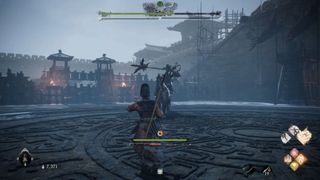
In Wo Long: Fallen Dynasty, though, which effectively splices Team Ninja's Nioh series with FromSoftware's Sekiro, parrying has become something I crave. It helps that, once you're tuned to its rhythm, the timing feels so instinctive. It helps that it comes with the perfect ker-ching sound effect and spark from your weapon, and sends iron-willed assailants into alarmed stumbles. But most of all it helps that it's a little bit forgiving and highly effective, so the gamble feels worthwhile.
It seems strange at first that the block and parry buttons are on opposite sides of the control pad in Wo Long: Fallen Dynasty. Parry actually doubles up with the dodge button – one tap for parry, two to dodge. But it's a masterstroke. It means you can parry while holding down the block command, so a late reaction isn't instantly punished, while a panicked mash of parry will at least see your martial artist warrior try to avoid the oncoming attack.
You do, however, have to be wary of your 'spirit', which replaces the stamina gauge found in Nioh and most Soulslike games, and goes up as you land blows, or down as you take damage, block, or cast spells. Blocking too often, then, will empty your spirit and leave you stunned, unless you're replying with strikes of your own. Enemies also have unblockable special attacks signified by a red glow that have to be parried or avoided, but if you can deflect them, you smash through their spirit, until they're stunned and open to a critical blow.
With all these clever tweaks, it's thus easier to adopt a 'why not?' attitude to parrying, doubly so against larger opponents, who seem to shrug off regular blows. In effect, it's more dangerous not to parry because you'll be forced to engage these enemies for longer, while a few well-timed deflections and a critical might destroy them in seconds, especially when you turn their hardest-hitting attacks against them. Plus instead of drawn-out exchanges you get explosive face-offs, which pivot dramatically in the blink of an eye. What's not to like?
Capture the Flag
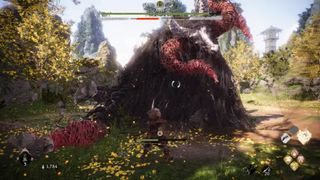
The art of deflection in Wo Long: Fallen Dynasty isn't the only evolution from the Nioh formula either, resulting in a more flexible and varied experience. For one, it has an especially encouraging attitude to teamwork, not only with its online co-op functionality, but with many of the game's levels adopting an opt-out policy to taking on an AI pal rather than the usual opt-in approach. Especially in Wo Long's first half, at the start of a level you are often gifted one or even two sidekicks to kick backsides with. The support they offer is nicely balanced too – they can generally be left alone to tackle minor enemies, but will get worn down by bosses if you don't pull your weight.
Mostly that's very welcome, because fighting more than one enemy at a time tends to be awkward, although the presence of multiple heroes can make for a more chaotic adventure. Sometimes enemies flit between attacking you and your buddy, leaving your strikes cleaving through thin air, while an overload of bodies can turn the melee into a mosh pit of swinging blades, until it becomes prudent to stand back and wait for things to calm down. Indeed, even on a couple of the (mostly excellent) bosses, I found it easier to dismiss my partner and go solo in order to maintain focus. It's perhaps best then to see employing AI help not merely as a means of decreasing the challenge, but a tactical consideration in its own right.
If this computerized cooperation is merely a qualified success, however, Wo Long: Fallen Dynasty makes a far more impressive fist of improving its level design. The Nioh games were always a little bland in this respect, and it feels as though Team Ninja has taken that criticism on board, turning thorough exploration of its spacious levels into a more enticing exercise. In part that's thanks to Wo Long's 'morale' system, which determines your overall strength at any given moment during a stage, as well as that of your enemies. Winning battles raises morale, while dying resets it. But if you raise your flag up flag poles hidden around a level, that increases your 'fortitude', or minimum morale, so death isn't so costly.
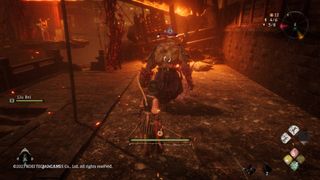
Scouring the levels to really get to grips with their geography, therefore, now has immediately tangible rewards. And because enemies have varying and visible morale levels too, you can see before engaging which are going to be especially strong and tough to dispatch, so you start to plan routes based on this information, perhaps avoiding an encampment until you loop back round to it later. Or, if you reach the end of the main path and find the boss too formidable, you can seek out any missed flags to power yourself up.
On top of this, the layout of the levels themselves is more tactically engaging than in the Nioh games. Striding nonchalantly through areas generally results in death by mob, but there's always at least one other way to approach a situation. It's usually possible to head round the back of a potential kill box and exterminate snipers, or hop onto roofs and battlements to scan the area or leap on foes from above. Often, flags are surrounded by a group made up of a leader and followers, and if you plan it right you can pick off the hench-demons one-by-one, weakening the unit's morale before tackling the main threat.
Nor do you have to be especially cunning to do this, because Wo Long often lets you get away with murder, thanks to enemies that are artificially stupid rather than artificially intelligent. They rarely bat an eyelid when you're having a furious battle with one of their colleagues not ten meters away. And even if it does register as you disembowel their buddy and let out a bloodcurdling war cry, they don't communicate their discovery to other friends. Frankly, it's extremely silly, but works in a game that purrs most smoothly when you're delivering stylish executions or waist deep in one-on-one combat.
Scrap Metal
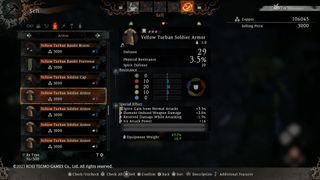
Where Wo Long: Fallen Dynasty does falter, though, is in its failure to fully address Nioh's laborious loot systems. Team Ninja may have taken another leaf out of Sekiro's book here and trimmed the bloat down, but instead it's pretty much business as usual. That is, the business of grabbing any shiny object lying around on the ground, whether they've been left unattended or fallen out of a dead enemy, and tossing it into the inventory with a shrug. Half the time, I only noticed what I had collected between missions when I visited the blacksmith to junk most of it for upgrade materials.
Generally, you'll find multiple copies of the same weapon or armor piece, differentiated only by the number of mini-perks they have attached. But this isn't the sort of game where fiddling with marginal stats – a couple of extra percent of fire damage here, or spirit gain there – matters unless you get really deep into the post-credits grind. Until then, it's a chore to sort through gear that's identical or objectively worse than what I already owned. I'm also pretty sure it's not the done thing in war to pick up and put on bits of a slain enemy's uniform, but Wo Long: Fallen Dynasty would have us believe otherwise.
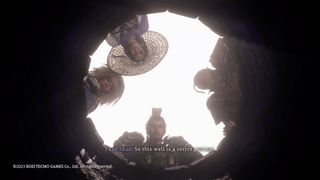
The storytelling in Wo Long: Fallen Dynasty is another area that could do with a dust and polish, especially since Team Ninja has gone to the trouble of starting afresh with its setting and mythology, shifting from Nioh's feudal Japan to late Han dynasty China. In structure and execution, though, the saga remains as undercooked as the last. You're pelted with factions and characters in a steady stream, with little time to remember who any particular person is before the next one arrives. Presumably, a little more historical knowledge on my part would go a long way here, but that doesn't account for the rushed plotting and editing, and a humdrum script that fails to bring these personalities to life.
While on the face of it the story in a systems-heavy game like Wo Long: Fallen Dynasty is a minor consideration, a better effort would surely add impetus to your adventure late on, when the level design patterns and enemies start to repeat a little too often. As with Nioh, this is a long game, and by the time you meet your 10th or 20th tiger demon and know its attack patterns better than it does, it's reasonable to ask for a more cohesive context to bind your efforts together.
Ultimately, though, no matter how many times you stare into the eye of the tiger, what counts most here is, well, the thrill of the fight, rising up to the challenge of your rivals. When you meet the largest or most fearsome foe head on, remain steadfast then push aside their best combo like a martial arts master, before spearing them through the gut, it's irresistibly exhilarating. Wo Long's cocktail of measured inputs and furious blows alone should keep the focused warrior going to the end. Keep calm and parry on.
Wo Long: Fallen Dynasty was reviewed on PS5 with code provided by the publisher.
More info
| Genre | Action RPG |
Jon Bailes is a freelance games critic, author and social theorist. After completing a PhD in European Studies, he first wrote about games in his book Ideology and the Virtual City, and has since gone on to write features, reviews, and analysis for Edge, Washington Post, Wired, The Guardian, and many other publications. His gaming tastes were forged by old arcade games such as R-Type and classic JRPGs like Phantasy Star. These days he’s especially interested in games that tell stories in interesting ways, from Dark Souls to Celeste, or anything that offers something a little different.

Ahead of GTA 6, Take-Two CEO says he’s “not worried about AI creating hits” because it’s built on recycled data: “Big hits […] need to be created out of thin air”
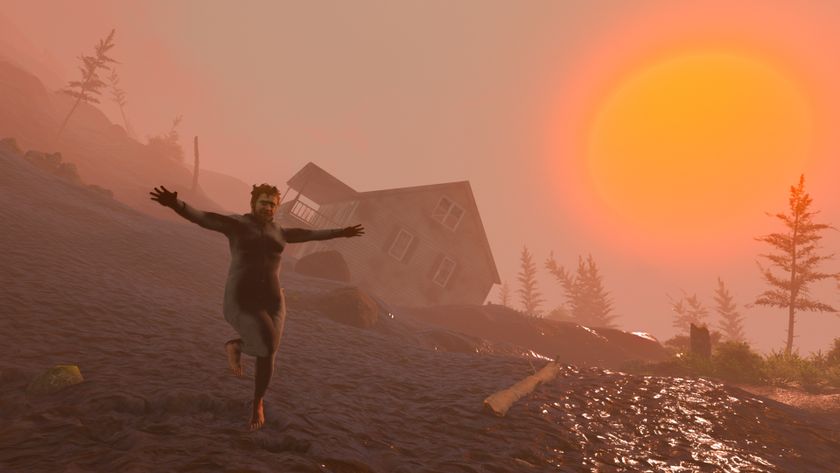
Getting Over It creator Bennett Foddy threatens the world once again: If you want Baby Steps to be a brutal rage game, "you can inflict that on yourself"

A Simpsons Hit and Run Remake will probably never happen – and I don't want it to
